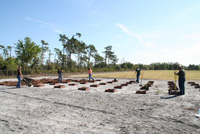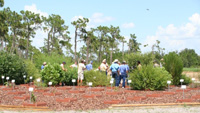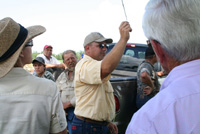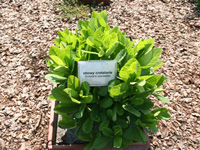A Forage and Weed Nursery for Pasture Management Education
Project description and objectives:
The forage and weed nursery located at the Range Cattle Research and Education Center near Ona, FL contains 205 species. Of these 205 species, there are 50 forages, and 155 weed species, with 7 of the 155 weeds being commonly found aquatic weeds. This nursery represents forage species that are utilized on both improved pastures and native rangeland. The purpose of the forage and weed nursery is to increase the awareness of ranchers on particular topics including forage quality, pest susceptibility, fertility, livestock stocking rates, plant poisoning, and other important factors related to grazing management. The weed component of the nursery serves as an identification resource for ranchers and ranchette owners.
Center near Ona, FL contains 205 species. Of these 205 species, there are 50 forages, and 155 weed species, with 7 of the 155 weeds being commonly found aquatic weeds. This nursery represents forage species that are utilized on both improved pastures and native rangeland. The purpose of the forage and weed nursery is to increase the awareness of ranchers on particular topics including forage quality, pest susceptibility, fertility, livestock stocking rates, plant poisoning, and other important factors related to grazing management. The weed component of the nursery serves as an identification resource for ranchers and ranchette owners.
Project activities:
A live 205 plot forage and weed nursery was established at the Range Cattle Research and Education Center near Ona, FL. Forages and weeds have been  established into 2 by 2 foot plots edged with recycled 2 by 6 inch plastic timbers. Some species, including aquatics and several invasive weeds that spread primarily by an extensive root system were buried in 20 gallon plastic barrels. To date, 175 weed and forage species have been established in the nursery and it is anticipated that the remaining species will be transplanted in 2008.
established into 2 by 2 foot plots edged with recycled 2 by 6 inch plastic timbers. Some species, including aquatics and several invasive weeds that spread primarily by an extensive root system were buried in 20 gallon plastic barrels. To date, 175 weed and forage species have been established in the nursery and it is anticipated that the remaining species will be transplanted in 2008.
On August 11, 2007 an educational program entitled ‘Grazing Management 101’ was held at the Range Cattle Research and Education Center. This program  detailed basic information concerning forages, fertility, and ended with a plot tour of the forage and weed nursery. Growers were introduced to many of the common weed species found in Florida pastures, including poisonous plants. They also learned various control techniques, including cultural and chemical control methods for several of the weed species. Time was also spent showing them the differences in growth habit of several of the commonly used forages, their advantages, and potential pests.
detailed basic information concerning forages, fertility, and ended with a plot tour of the forage and weed nursery. Growers were introduced to many of the common weed species found in Florida pastures, including poisonous plants. They also learned various control techniques, including cultural and chemical control methods for several of the weed species. Time was also spent showing them the differences in growth habit of several of the commonly used forages, their advantages, and potential pests.
Project accomplishments:
Ranchers and ranchette owners who attend educational events or simply stop in at the forage and weed nursery will be able to learn various forage and weed species. Upon further examination, they will be able to learn which forage is best  suited for their given situation and what weeds can be expected in their pasture. After learning which forage is best suited for their situation, they can find additional information at the Range Cattle REC concerning proper management and fertility, which can increase the competitiveness of the forage against many of the weed species in Florida. Cultural inputs, such as these, may help growers avoid herbicide applications, which will help them reduce production costs and potentially decrease potential environmental risks associated with herbicides. The poisonous plants located in the forage and weed nursery also give growers an idea of how plant pests can reduce both human and animal welfare.
suited for their given situation and what weeds can be expected in their pasture. After learning which forage is best suited for their situation, they can find additional information at the Range Cattle REC concerning proper management and fertility, which can increase the competitiveness of the forage against many of the weed species in Florida. Cultural inputs, such as these, may help growers avoid herbicide applications, which will help them reduce production costs and potentially decrease potential environmental risks associated with herbicides. The poisonous plants located in the forage and weed nursery also give growers an idea of how plant pests can reduce both human and animal welfare.
Project leader:
Dr. Brent Sellers, Assistant Professor, Agronomy, Range Cattle Research and Education Center, UF